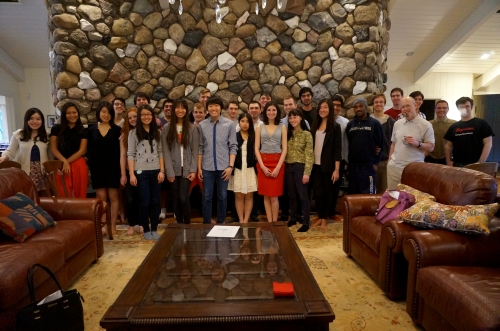With a hat-tip to our occasional commenter Alan Wexelblat…..flying robots making music!!! (Best viewed fullscreen; click in the lower right corner.)
With a hat-tip to our occasional commenter Alan Wexelblat…..flying robots making music!!! (Best viewed fullscreen; click in the lower right corner.)
Last week, I posted video of my talk to the undergraduate math students on truth, provability and the fabric of the universe — and heard from several readers who requested that I post it in a non-flash format.
My readers’ wish is my command. Here is the file for download in an m4v format.
This is relatively low resolution. The best viewing is still the flash version here.
Spread Networks recently spent $300 million to build a fiberoptic cable that will let Wall Street traders shave .003 seconds off their execution times.
What’s the social value of that cable? If you can shave .003 seconds off the time it takes to execute a trade, how much good have you done the world?
Clearly, the full value of the cable resides in its ability to get things done faster. So start with a vast overestimate: Suppose the entire economy is on hold waiting for that trade to be completed. Then, thanks to the cable, we can all get on with our lives .003 seconds sooner and produce an extra .003 seconds worth of output.
In a $15-trillion-a-year economy, that comes to about $1500.
If we assume, more realistically, that just 1/1000 of the economy is hanging fire waiting for this one trade, the social contribution of a .003-second speedup is roughly $1.50. I’m confident it’s even more realistic to replace that 1/1000 with 1/1,000,000 . That gets us down to about an eighth of a cent.
But chances are you’d be willing to pay a hell of a lot more than an eighth of a cent for that extra speed, which is why Spread Networks is willing to pour $300 million into this thing, and why, quite generally, we should expect there to be more invested in such projects than they return in social value.

The undergraduate Finance and Economics Council here at the University of Rochester held an event at my house last week, which included pizza, informal chat with professors, a rationality test (out of 31 students, exactly one scored a perfect 5 and one scored a perfect zero), a selfie shot or two, and some time on the aerial silks, where three students were brave enough to go up in the air — and each of them accomplished more in under ten minutes than I accomplished in my first ten weeks. The evidence:
|
|
|
| Demo | Lance Floto Front Salto Dive |
| _________________________________________________________ | |
|
| |
| Juan Bernardo Tobar Front Salto Dive |
Lev Bokeria Crossback Straddle |
Thanks to Council president Shucen Wu for making this happen, to Zach Taylor for the video, and to everyone who participated. We should do this again.
Here is my talk to the University of Rochester’s Society of Undergraduate Math Students on “Truth, Provability and the Fabric of the Universe”. The audience was great, and except for a couple of slips of the tongue (like “Sir William of Ockham” for “William of Ockham”), I thought it went very well.
Faithful readers will recognize multiple themes from the book The Big Questions, and from numerous past blog posts, including:
Continue reading ‘Truth, Provability and the Fabric of the Universe’
Remember Paul Krugman? You know, the guy who thinks we’re so deep in a liquidity trap that pretty much all spending is good spending, even if it’s socially wasteful?
Well, here’s something odd. That very same Paul Krugman is outraged to the core by expenditures on fiberoptic cables to support high frequency trading — expenditures that I happen to agree represent a giant social waste.
“We’re giving huge sums to the financial industry for little or nothing in return”, gripes the very same Krugman who thought it was a swell idea to stimulate the economy through hundreds of billions in government spending, whether or not we got anything in return.
It’s true that Keynesian economists have reasons to believe that wasteful spending is sometimes good. But honest Keynesian economists tend to acknowledge that those reasons apply equally well to both private and public spending.
Krugman’s view, apparently, is that, at least in the current climate, wasteful spending is good as long as you’re spending taxpayer’s money, but bad if you’re spending your own money. That’s not Keynesianism. It’s just crankiness.
 |
 |
Well, nobody’s perfect.
When it comes to skewering bad reasoning — and making the right arguments crystal clear — Don Boudreaux is usually about as close to perfect as anyone gets. But this time I believe he’s committed a gaffe of his own.
In a column on the minimum wage, Don writes:
Suppose that I invent and use a machine to steal $15,000 every year from each of 500,000 poor Americans, with the $7.5 billion being transferred into my Swiss bank account. After skimming off a few hundred million bucks to cover processing and handling expenses, I share the bulk of these proceeds with about 16.5 million friends…Am I acting immorally? Most people would answer “yes”…
By way of context, a CBO study forecasts that raising the minimum wage to $10.10 per hour will cause 500,000 workers to lose their $15,000-a-year jobs, while raising the pay of 16.5 million others.
But Don’s analogy fails, because taking someone’s $15,000-a-year job is not the same thing as taking someone’s $15,000. I think it’s a fair guess that most minimum wage workers dislike their jobs. So losing one of those jobs has an upside, which has to be weighed against the downside of not getting paid. On balance, losing that $15,000-a-year job might be no more painful than losing, say, $5000 a year.
The right version of Don’s analogy, then, goes more like this:
Mark Perry and Andrew Biggs argue in the Wall Street Journal that
These gender-disparity claims [the claims that women are paid 23% less than men for the same work] are also economically illogical. If women were paid 77 cents on the dollar, a profit-oriented firm could dramatically cut labor costs by replacing male employees with females. Progressives assume that businesses nickel-and-dime suppliers, customers, consultants, anyone with whom they come into contact — yet ignore a great opportunity to reduce wages by 23% [by hiring women instead of men].
Well, first of all, even if we take the gender disparity claims at face value, this doesn’t add up to an opportunity to reduce wages by 23%. Only about half the work force is female, so the average firm, if it replaced all of its men with women earning 23% less, would reduce its wage bill by only about 11.5%.
Beyond that, the Perry/Biggs argument appears to founder on the observation that lazy and incompetent managers do in fact manage to ignore profit opportunities all the time. Why, then, is it so hard to imagine that they’re ignoring this one?
Fortunately, I’m here to fill the gap —- by figuring out just how big a profit opportunity we’re talking about.
 Once upon a time, the New Yorker took special pride in its famously scrupulous fact-checking department. Nowadays, they’ve apparently stopped caring whether the pieces they publish are even remotely plausible, let alone true.
Once upon a time, the New Yorker took special pride in its famously scrupulous fact-checking department. Nowadays, they’ve apparently stopped caring whether the pieces they publish are even remotely plausible, let alone true.
Thus, writing about the Affordable Care Act in the current issue, Jeffrey Toobin is able to report that “it’s clear that the law is helping a lot of Americans” because, among other things, “more than a hundred million people have received preventive-care services, like mammograms and flu shots, at no cost!!!!!!!!!!!!!!!!!!!!!!!!!!!” (Emphasis added.)
Now surely nobody at the New Yorker, right down to the greenest intern, can possibly believe that it is possible to provide a mammogram or a flu shot at no cost. The statement is so ridiculous that one has to believe either that it was intended as some sort of parody (a reading which the context does not support) or that Toobin meant to say something entirely different. But what?
 Max Tegmark is a professor of physics at MIT, a major force in the development of modern cosmology, a lively expositor, and the force behind what he calls the Mathematical Universe Hypothesis — a vision of the Universe as a purely mathematical object. Readers of The Big Questions will be aware that this is a vision I wholeheartedly embrace.
Max Tegmark is a professor of physics at MIT, a major force in the development of modern cosmology, a lively expositor, and the force behind what he calls the Mathematical Universe Hypothesis — a vision of the Universe as a purely mathematical object. Readers of The Big Questions will be aware that this is a vision I wholeheartedly embrace.
Tegmark’s new book Our Mathematical Universe is really several books intertwined, including: